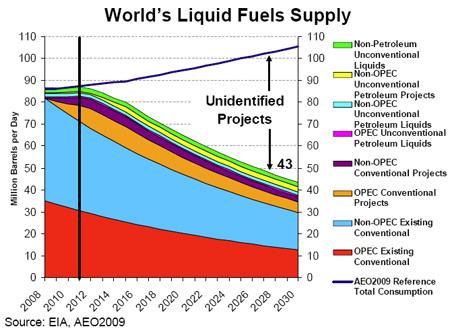Eugene Climate Inaction Plan 2.0: 2019 update
no mention of Beltline widening, fossil fuel depletion, Phil Knight's new sports arenas, limits to growth on a finite planet
written in part by Good Company consultancy, which promotes plastic incineration as an ecological practice on behalf of American Chemistry Council
Carbon Reduction Action Plan (CRAP)
"Those who can make you believe absurdities, can make you commit atrocities."
- Voltaire
50% cut in energy by 2030?

Meeting the World’s Demand for Liquid Fuels A Roundtable Discussion
A New Climate For Energy EIA 2009 Energy Conference
April 7, 2009 Washington, DC
| Climate Inaction Plan | what it really means |
title page: Eugene's Community Clmate Action Plan 2.0: |
has a nice photo of a buccolic natural scene in Eugene. The report has more space dedicated to nice photos of parks, bikes and farmers market than discussion of implementation of lofty goals. |
page 12 The Climate Recovery OrdinanceThe Eugene City Council passed the Climate Recovery Ordinance (CRO) in 2014 and updated the ordinance in 2016 with a community-wide greenhouse gas emissions goal. The four climate goals in the CRO are:
|
replies: Since the "CRO" was passed, flight operations increased at EUG airport, a City owned facility. It is a joke inside City administration that then Mayor Piercy made City Hall "carbon neutral" by demolishing it. In 2030, the fracking bubble may be over and the era of permanent energy rationing may finally have arrived. It won't be climate that causes this, but physical depletion, a verboten topic to the professional sustain-a-bull industry. In 2030, the Alaska Pipeline may also be over due to low flow shutdown. Whenever that happens, citizens of the Cascadia region will unlikely be able to use half of our current usage, even if we want to. The pipeline peaked at over 2 million barrels a day in 1988 and is now about a half million day (2019). Estimates vary on how much northwest Alaska (opened for drilling in 1998) and northeast Alaska (not yet opened for drilling) but even the largest estimate suggest less than that extracted from Prudhoe Bay (over 17 billion barrels since 1977). Most of the petroleum used in Oregon and Washington comes from Alaska via refineries in Puget Sound. This energy runs nearly all of the cars, planes, trains, ships and food delivery trucks in the region. As for a goal of 2100, the fossil fuels will be a memory then, and likely, too, our AWOL (American Way of Life). A goal for nearly a century in the future is convenient for politicians who won't be in office then ... while ignoring urbanization, highway expansion, economic growth, brittle transnational food delivery networks and corporate clearcuts that are drying out Oregon forests. |